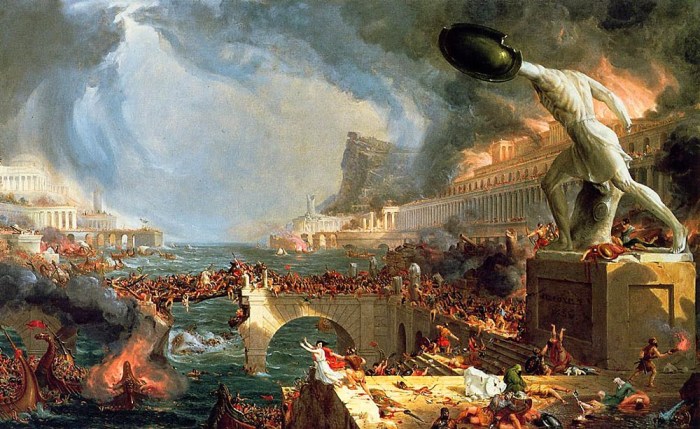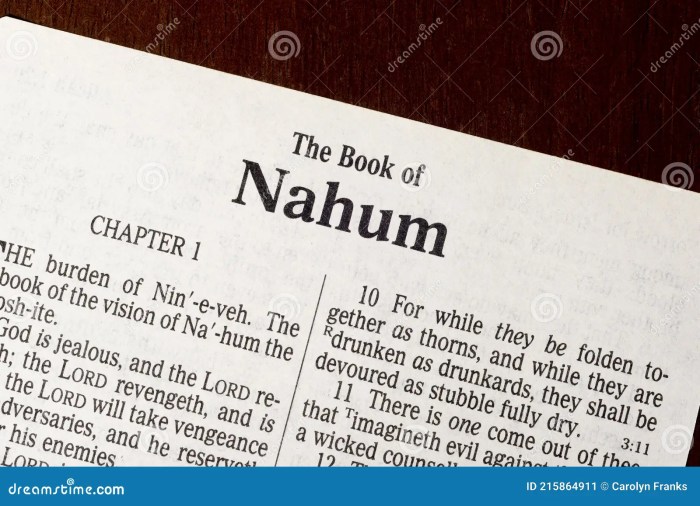The book of nahum relates the destruction of edom. – The Book of Nahum relates the destruction of Edom, providing a glimpse into the ancient world’s religious beliefs, political dynamics, and the consequences of divine judgment.
Nahum’s prophecy, delivered in the 7th century BCE, targeted Edom, a nation known for its hostility towards Israel. This essay analyzes the significance of Edom in Nahum’s prophecy, explores the reasons for its impending doom, and examines the literary devices and theological implications of its destruction.
Introduction to the Book of Nahum

The Book of Nahum is a prophetic book in the Hebrew Bible. It is attributed to the prophet Nahum, who lived in the seventh century BCE. The book contains a prophecy against the Assyrian city of Nineveh, the capital of the Neo-Assyrian Empire.
Nahum prophesied that Nineveh would be destroyed by God for its wickedness and oppression of other nations.
Nahum’s Prophecy against Edom
Edom was a nation located to the southeast of Judah. The Edomites were descendants of Esau, the brother of Jacob. In the time of Nahum, Edom was a vassal state of Assyria. However, the Edomites had a history of raiding and attacking Judah.
Nahum prophesied that Edom would be destroyed by God for its wickedness and its hostility towards Judah.
Analysis of the Destruction of Edom, The book of nahum relates the destruction of edom.
Nahum’s prophecy against Edom is full of vivid imagery and literary devices. He describes Edom as a “land of darkness and gloom” and a “den of dragons.” He prophesies that Edom will be “plundered” and “laid waste.” Nahum’s prophecy also has theological implications.
It shows that God is just and will punish those who do evil.
Impact of the Prophecy on the Ancient World
Nahum’s prophecy against Edom had a significant impact on the ancient world. The prophecy helped to weaken the morale of the Edomites and contributed to the eventual destruction of Edom by the Babylonians in 586 BCE. The prophecy also served as a warning to other nations that God would not tolerate wickedness and oppression.
Relevance of the Prophecy Today
The prophecy of Edom’s destruction can be applied to contemporary situations. It teaches us that God is just and will punish those who do evil. It also teaches us that we should not be afraid to stand up for what is right, even when it is difficult.
Answers to Common Questions: The Book Of Nahum Relates The Destruction Of Edom.
What is the historical context of Nahum’s prophecy?
Nahum’s prophecy was delivered during a period of political upheaval and conflict in the ancient Near East. Assyria, a powerful empire, had recently conquered Israel and was threatening Judah. Edom, a neighboring nation, had sided with Assyria and was seen as a threat to Judah.
Why did Nahum prophesy against Edom?
Nahum prophesied against Edom because of its hostility towards Israel and its alliance with Assyria. Edom had participated in the destruction of Jerusalem and the exile of the Israelites. Nahum’s prophecy condemned Edom’s actions and predicted its own destruction.
What are the literary devices used by Nahum to describe Edom’s destruction?
Nahum uses vivid imagery and poetic language to describe Edom’s destruction. He compares Edom to a burning forest, a crumbling mountain, and a desolate wasteland. He also uses metaphors and similes to convey the severity of Edom’s punishment.

